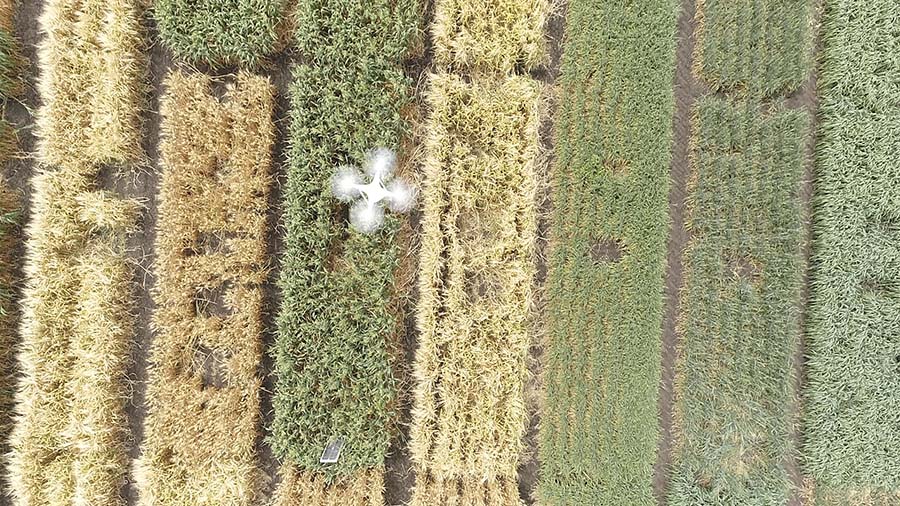Australian grain growers are set to get better crop variety recommendations faster through a major GRDC international collaborative investment.
The $5.39 million five-year INVITA (Innovations in Variety Testing in Australia) investment will deliver improved predictors of variety performance, quicker access to trial data for growers, better monitoring of trial quality and variety responses to environmental stresses – underpinning greater grower profitability.
GRDC Senior Manager Enabling Technologies, Tom Giles, says INVITA will add value to GRDC’s flagship National Variety Trials (NVT) program by further enhancing the quality and timeliness of NVT varietal performance data.
“Knowing the likely performance of varieties under various environmental conditions will provide growers with more confidence in their crop variety decision making,” Mr Giles says.
“The NVT program is a huge logistical undertaking – it is the one of the largest co-ordinated field trial networks of its kind in the world. The INVITA investment adds value to historical NVT data and introduces new technologies and analysis methods to ensure that the NVT program remains at the forefront of variety testing.”
Mr Giles says GRDC's investment is being undertaken in partnership with laboratories in Europe where there has been significant investment in the systematic development of remote sensing, imaging technology and data analytics to monitor and predict crop performance through the Horizon 2020 Innovations in Plant Variety Testing in Europe (INVITE) program.
“The Australian initiative is leveraging advances being made within the INVITE program. We are utilising cutting-edge technologies, techniques and capabilities from across the globe to give Australian grain growers the most dynamic, informative, timely and robust data so they can select with confidence the most appropriate varieties for their farming systems and unique environmental conditions.”
Leading the INVITA research at The University of Queensland is Professor Scott Chapman, who has long-standing ties with a key INVITE partner, Wageningen University in the Netherlands, the top-ranked university in the world for agricultural research. Australia’s leading agriculture research agency, CSIRO, is the other major collaborator.
Professor Chapman, who discusses the investment in a new GRDC video, says INVITA embraces the use of drones, satellite images and paddock-based sensors and cameras, with experts in statistics, simulation modelling, machine learning, crop physiology/phenotyping and satellite imaging involved.

INVITA embraces the use of drones, satellite images and paddock-based sensors and camera, with experts in statistics, simulation modelling, machine learning, crop physiology/phenotyping and saellite imaging involved. Photo: The University of Queensland
“The crop monitoring technology will focus on capturing data on environmental conditions in addition to crop growth, yield and health characteristics,” Professor Chapman says.
“That will aid us in developing analytical tools capable of predicting crop performance in ways that account for impacts from environmental variables within trials – moving the science closer to being able to extend predictions to farms.”
INVITA commenced with field trials focused on bread wheat varieties, and other crop types will be considered for inclusion this year. In the European project, data is also being captured for canola, maize and sunflowers.
“In 2020, 90 wheat field sites across Australia hosted the remote-sensing technology,” Professor Chapman says. “Included were a subset of about 50 NVT locations which were selected to host ancillary trials.”
The ancillary trials fall under two classes: BioCal and SatCal sites. The SatCal sites include satellite data collection to provide a constant point on Earth to align the satellite images with NVT trials.
The BioCal (short for biomass calibration trial) sites involve six different wheat types (sourced from the NVT) planted at different densities and sampled three times during the season. All trials at these sites were imaged using drones equipped with RGB (standard red-green-blue cameras) or with multispectral cameras that include NIR (near infra-red) and NRE (near red edge) wavelengths to match with satellite imaging. The drone data is being processed to generate detailed field maps at less than one-centimetre resolution.
In addition, the BioCal sites include fixed 4G cameras that transmit single-plot images four times a day, canopy temperature sensors and, at a few sites, Arable Mark weather station/reflectance sensors.
Three trial sites managed by The University of Queensland, CSIRO and the South Australian Research and Development Institute (the research division of the SA Department of Primary Industries and Regions) were also subject to more intensive in-season crop performance assessment (or phenotyping) than the NVT sites.
Examples of the new capabilities include software that uses drone-derived or smartphone data to estimate early crop cover or count wheat heads or, alternatively, uses satellite images and drone-derived imagery to estimate leaf area and biomass. These estimates can then be run against environmental conditions and other data to mine deeper correlations.
Along the way, project activities are helping to upskill NVT Service Providers in the use of remote sensing technology. As this becomes established technology, the broader agricultural research community also stands to benefit through the commercial availability of services for steady streams of paddock-relevant data.
“The strength of INVITE and INVITA’s approach is the ability to integrate the satellite, drone and observational data while advancing the ability to extract useful information from images,” Professor Chapman says.
“The result is an integrated platform that allows a new understanding about the way varieties and environments interact that will prove especially useful when analysing performance of varieties in the NVT trials.”
A new podcast detailing the investment is available. More information about the INVITA investment can also be found in GroundCover story Sensing advances to lift crop trials to a new level.

























































